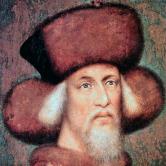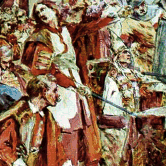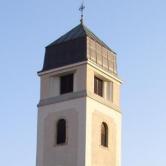History > Križevci Bloody Assembly
After the king's death, a series of weak kings came to the Croatian-Hungarian throne, which in turn led to constant disputes over the throne, later involving neighbouring rulers, too. The country was plagued by feudal anarchy, and the Croatian nobles grew so powerful that the strongest among them, the rulers of the Šubić family of Bribir, autonomously ruled the country. It was the Šubić family who finally brought a new dynasty, the Angevin dynasty from Naples, to the throne. There were some disputes between the Croatian nobles and the Angevin rulers due to the fact that neither the Croatian nor the Hungarian nobles were satisfied with Angevin absolutist rule.In 1914 an oil painting called Križevci Bloody Assembly in 1397 was displayed on the arch of the Church of the Holy Cross. This painting is one of the greatest works of a famous Croatian painter, Oton Iveković, who often turned to history for inspiration. In the 18th century Baltazar Adam Krčelić, the Croatian historian and chronicler, was the first to refer to the Assembly as the "Bloody Assembly".
Since King Ludovik I had no male heirs, he had named his daughter, Marija, as his successor. Marija was only 12 when he died, so her mother, Elizabeta Kotromanić, ruled instead of her, and this in turn led to further disputes.
Some nobles, like Croatian Banus Stjepan Lacković, Bosnian king Stjepan Tvrtko I, and Hrvoje Vukčić Hrvatinić, supported the Queen. Those who opposed the Queen were led by Horvat brothers and the prior of Vrana, Ivan of Palizna. Besides Marija and Elizabeta, among possible candidates to succeed the throne were also duke Karlo Drački Angevin, his son Ladislav of Naples, and Marija's fiancee, who would later become her husband, Sigismund of Luxembourg, the son of a Czech king. After constant fights, Sigismund finally took over the throne, killing 30 Croatian nobles. Thus Sigismund came out a winner in the rebellions of the nobles of Central Croatia and Slavonia against the absolutist rule of the court.There are no records of the exact site of the Bloody Assembly of Križevci. Historians usually agree that there are three possible sites: the town Assembly House, the Church of the Holy Cross, and the Royal Residences. Although the painting with the scene of the Assembly is displayed in the Church, it seems the least likely place for the Assembly to be held in, since it is situated outside the town walls. The Assembly was probably held in the old Assembly house (today the Gallery of Fine Arts).
In addition to the disputes over the Croatian-Hungarian throne, there was another danger looming on the horizon-the Turks and the Ottoman Empire. In order to gain some respect, Sigismund recruited his forces and attacked the Turks with the intention of driving them out of the Balkans. In 1396, Sigismund suffered a massive defeat at the battle of Nikopolje, in Bulgaria. He managed to escape by sailing down the Danube River to the Black Sea in a boat. There was no sign of him for months so nobody in Croatia or Hungaria knew if he was still alive.
Due to this uncertainty over the King's survival, another rebellion broke out, and the Croatian nobles started supporting Ladislav of Naples. Upon his return to Croatia through Dubrovnik in 1397, king Sigismund summoned the nobles of the Slavonia region to Križevci, where the Assembly was usually held. The Assembly was attended by the representatives of the opposing sides-the adherents of Sigismund on one side and Ladislav's supporters, led by Stjepan Lacković, on the other.
Sigismund issued a written guarantee (saluus conductus) stating he would not attempt personal revenge on the opponents or harm them in any way. Lacković actually believed the King so he came to Križevci together with his supporters. The Assembly was held during the last week of February, in 1397. The supporters of Ladislav were outnumbered by Sigismund's adherents (the banus, Kaniski brothers, count Herman of Celje, etc.), who came to Križevci to greet their King. At first everything was going well, but then a bitter dispute broke out between the opponents.
Since Lacković's forces were waiting for him outside the town, Sigismund's adherents started accusing Lacković of being a traitor, and luring the Turks into his homeland, while Lacković's supporters blamed Sigismund for the defeat at Nikopolje. The dispute ended in bloodshed, when Sigismund's adherents drew their swords and massacred Lacković and his supporters, Lacković's son in law, Andrija, being one of them. After the massacre, their bodies were thrown out of the window of the Assembly House. The massacre took place on Tuesday, 27th of February, 1397, and became known as Križevci Bloody Assembly.
When Lacković's forces, encamped outside the town, found that their leader was murdered, they stormed Križevci. Sigismund's adherents threw Lacković's body out of the tower into the trench shouting angrily at Lacković's raging supporters: "Stop this foolishness, you wretched men who are willing to die for the one who is already dead?!" Upon those words, thesupporters ran away in fear. "Križevci Bloody Assembly" resulted in Sigismund's fear of the revenge of Lacković's men, new rebellions of the nobles in Croatia and Bosnia, the death of 170 Bosnian nobles who were killed by Sigismund, and selling off Dalmatia to Venice for 1000 golden coins by Ladislav of Naples. Thus, after 25 years of fighting, Sigismund succeeded in seizing power and was finally recognized as a king.




